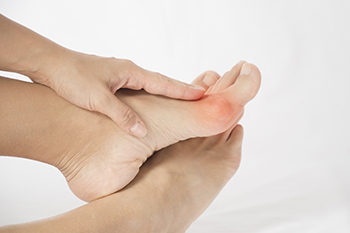
A bunion is a bony bump that forms on the joint at the base of the big toe. It develops when the big toe pushes against the next toe, forcing the joint to protrude. Symptoms include a visible bump, swelling, redness, soreness, pain while walking, and restricted toe movement. The area may look misaligned and feel tender, especially in tight shoes. Bunions can be caused by genetics, wearing tight or narrow shoes, flat feet, or arthritis. Over time, they can worsen and lead to chronic discomfort or difficulty walking. A podiatrist can assess the severity of the bunion through a physical exam and X-rays. Treatments may include recommending wider shoes, custom orthotics, padding, anti-inflammatory medications, or night splints. In severe cases, surgical correction may be considered to realign the toe and relieve pain. If you are dealing with painful bunions, it is suggested that you schedule an appointment with a podiatrist for appropriate treatment.
If you are suffering from bunions, contact one of our podiatrists of Mt Rose Foot & Ankle Specialists. Our doctors can provide the care you need to keep you pain-free and on your feet.
What Is a Bunion?
A bunion is formed of swollen tissue or an enlargement of boney growth, usually located at the base joint of the toe that connects to the foot. The swelling occurs due to the bones in the big toe shifting inward, which impacts the other toes of the foot. This causes the area around the base of the big toe to become inflamed and painful.
Why Do Bunions Form?
Genetics – Susceptibility to bunions are often hereditary
Stress on the feet – Poorly fitted and uncomfortable footwear that places stress on feet, such as heels, can worsen existing bunions
How Are Bunions Diagnosed?
Doctors often perform two tests – blood tests and x-rays – when trying to diagnose bunions, especially in the early stages of development. Blood tests help determine if the foot pain is being caused by something else, such as arthritis, while x-rays provide a clear picture of your bone structure to your doctor.
How Are Bunions Treated?
- Refrain from wearing heels or similar shoes that cause discomfort
- Select wider shoes that can provide more comfort and reduce pain
- Anti-inflammatory and pain management drugs
- Orthotics or foot inserts
- Surgery
If you have any questions, please feel free to contact our office located in Reno, NV . We offer the newest diagnostic and treatment technologies for all your foot care needs.
